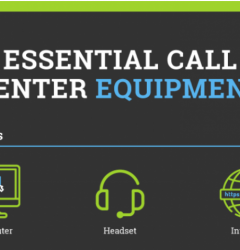
Of course you want your call center to do well and run effectively, but the question is how do you achieve that goal? Don’t waste any more time wondering what to do. Let’s break it down, so it’s manageable and simple to determine the best organizational structure for your call center.
How to Structure Your Call Center Team?
Structuring your call center team starts with understanding what roles are necessary and what part they play in the team. Teams always work best when everyone knows their responsibility and how the parts of the team function together. Call center teams also work best when there is a hierarchy of roles to promote areas of ownership and distribution of decision making.
Call Center Agents
The call center agents are considered the lowest on the hierarchy chart, however, this does not mean that they are least important. Agents have to practice critical thinking and decision making to help the customers, resolve issues and sell products/services. They should also be able to provide information about your product/service and answer questions.
There are 2 main types of call center agents:
Sales representatives
A sales rep is an individual who helps sell your product or service to other companies. This could mean selling directly to clients, or through distributors. While sales representatives would be considered low on the hierarchy chart they are incredibly valuable. Sales reps might require more coaching and monitoring than customer support agents, however, they have to practice discernment on selling methods and must be able to effectively build relationships with customers. These skills can be hard to come by but they are a vital part of the sales representative role.
Customer support agents
Customer support agents are the heart of any call center. They take calls from customers and handle them accordingly. There are many types of agents: service, technical, customer care, etc. Each type of agent requires specific skills and knowledge. Unlike other roles in business, customer support agents require minimal supervision and must be able to work independently, for the most part.
Team Leaders
These individuals lead teams of agents. Their main responsibility is to ensure that each agent performs his/her job effectively. A good team leader has the ability to delegate tasks and provide feedback to his/her team members.
Supervisors
Supervisors oversee teams of agents, ensuring they’re working efficiently and effectively. Their primary role is to ensure that agents are trained properly, so they know what to say and do to provide excellent service.
Their secondary role is to ensure that everyone is doing their job correctly, so they can spot any problems before they escalate. They manage the workloads of each agent so that there are no bottlenecks. They also monitor performance and provide feedback to agents.
Managers
Managers oversee the whole team, including supervisors and team leads. They are the ones responsible for choosing tools, such as a power dialer. This role is placed highest in the hierarchy chart, as it comes with the most responsibilities and requires a certain type of skill set or experience.
What to Consider When Structuring Your Call Center
No two call centers are the same. They might have similar goals and similar processes but they all vary in miscellaneous ways. While one organizational structure might work for one call center it might not work from another. That’s why it’s important to consider a few things before structuring your call center.
Call Center Size
Small centers tend to have fewer employees per department than larger ones. This means that there are less opportunities for career advancement. Small centers often have one manager per department. Larger centers usually have multiple managers per department.
Call Center Location
If your call center is located in another country, it’s important to consider cultural differences when structuring your team. Having this is mind, you can either pull your agents from that geographical location or train them, so they are able to effectively represent the call center and the location in which it serves.
The Type of Call Center
No matter the type of call center, having an inbound or an outbound call center guide is beneficial to managers who have little to no experience in call centers.
On-site or Virtual Call Center
To go virtual or to not go virtual. It’s not necessarily an easy decision because there are benefits and disadvantages to both options. Let’s start with option one: starting a virtual call center.
Pros:
-Bigger pool for choosing employees because commuting it not an issue
-Do not have to have a physical location to house hardware, software or other business tools
-Improved retention rates
-Extended available work hours because agents can be available for odd hours due to time zones
Cons:
-Can be difficult to train employees
-Can be difficult to monitor and coach employees
-Can have reduced synergy
Now let’s look at the other option. Starting an on-site call center:
Pros:
-Easier to train, monitoring and coach employees
-Manager has more control over the day-to-day
-Synergy is usually higher due to the benefits of on-site benefits (work parties, luncheons , etc)
-Easier to interact and collaborate with other departments/teams
Cons:
-Have to provide office building, software, hardware, and other necessary business tools
-Employee pool is smaller due to commute
There isn’t a right or wrong answer, only what option will work best for your call centers needs.
Now on to managing your team. It may take some time, but developing good call center management requires patience, commitment, and planning. You shouldn’t expect to be perfect from day one. Pro Tip: Use Q&A to improve your team’s performance month after month and year after year. If you follow these steps, you’ll be able to create an effective management practice to support your team!

